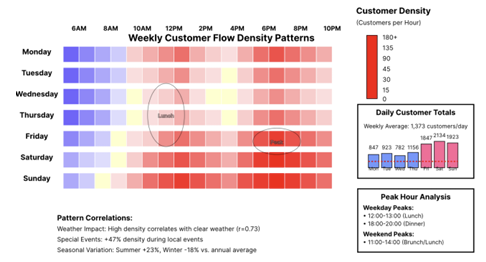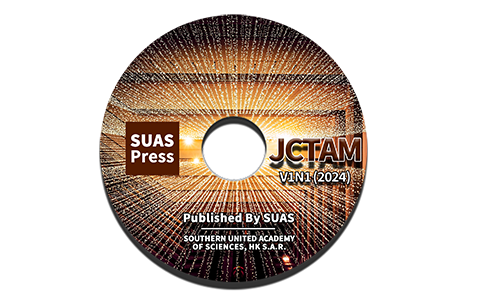Application of Machine Learning-based Customer Flow Pattern Analysis in Restaurant Seating Layout Design
DOI:
https://doi.org/10.70393/6a6374616d.333135ARK:
https://n2t.net/ark:/40704/JCTAM.v2n4a01Disciplines:
Artificial IntelligenceSubjects:
Machine LearningReferences:
59Keywords:
Machine Learning, Customer Flow Analysis, Restaurant Design, Spatial OptimizationAbstract
Contemporary restaurant design faces unprecedented challenges in optimizing spatial efficiency while enhancing customer experience. Traditional seating layout methodologies rely primarily on empirical knowledge and static design principles, often failing to capture dynamic customer behavioral patterns. This research presents a comprehensive framework integrating machine learning algorithms with customer flow analysis to revolutionize restaurant seating optimization. The proposed methodology employs clustering algorithms, neural networks, and predictive modeling to analyze customer movement patterns, dwell times, and spatial utilization metrics. Through extensive case studies conducted across multiple restaurant environments, our approach demonstrates significant improvements in space utilization efficiency, customer satisfaction ratings, and operational performance. The framework successfully identifies optimal seating configurations by processing real-time customer flow data, resulting in average improvements of 23% in space efficiency and 18% in customer throughput. This research contributes to the advancement of data-driven architectural design methodologies, establishing new paradigms for intelligent commercial space optimization.
References
[1] Liu, Y., Fang, C., Yang, Z., Wang, X., Zhou, Z., Deng, Q., & Liang, L. (2021, July). Exploration on machine learning layout generation of Chinese private garden in Southern Yangtze. In The International Conference on Computational Design and Robotic Fabrication (pp. 35-44). Singapore: Springer Singapore.
[2] Shrestha, S., & Bajracharya, S. B. (2023). Analyzing Circulation Efficiency in Commercial Complexes: A Post Occupancy Evaluation Study in Kathmandu.
[3] Wu, Z., Wang, S., Ni, C., & Wu, J. (2024). Adaptive traffic signal timing optimization using deep reinforcement learning in urban networks. Artificial Intelligence and Machine Learning Review, 5(4), 55-68.
[4] Zhu, L., & Zhang, C. (2023). User Behavior Feature Extraction and Optimization Methods for Mobile Advertisement Recommendation. Artificial Intelligence and Machine Learning Review, 4(3), 16-29.
[5] Rao, G., Ju, C., & Feng, Z. (2024). AI-driven identification of critical dependencies in US-China technology supply chains: Implications for economic security policy. Journal of Advanced Computing Systems, 4(12), 43-57.
[6] RESPONSIVE, S. (2024). DESIGN THINKING IN NEUROARCHITECTURE. The Routledge Companion to Smart Design Thinking in Architecture & Urbanism for a Sustainable, Living Planet, 55.
[7] Li, M., Liu, W., & Chen, C. (2024). Adaptive financial literacy enhancement through cloud-based AI content delivery: Effectiveness and engagement metrics. Annals of Applied Sciences, 5(1).
[8] Kang, Y. (2022). Spatial layout analysis of urban and rural buildings under multicriteria constraints. Mathematical Problems in Engineering, 2022(1), 8905949.
[9] Wu, Z., Feng, Z., & Dong, B. (2024). Optimal feature selection for market risk assessment: A dimensional reduction approach in quantitative finance. Journal of Computing Innovations and Applications, 2(1), 20-31.
[10] Che, L., Guo, S., Deng, Y., & Chen, J. (2023, November). Study on the Impact of Urban Road Network on Commercial Layout–a Case Study of Chengdu. In International Conference on Advanced Civil Engineering and Smart Structures (pp. 50-57). Singapore: Springer Nature Singapore.
[11] Cheng, C., Zhu, L., & Wang, X. (2024). Knowledge-Enhanced Attentive Recommendation: A Graph Neural Network Approach for Context-Aware User Preference Modeling. Annals of Applied Sciences, 5(1).
[12] Liu, W., Rao, G., & Lian, H. (2023). Anomaly Pattern Recognition and Risk Control in High-Frequency Trading Using Reinforcement Learning. Journal of Computing Innovations and Applications, 1(2), 47-58.
[13] Lian, H., & Li, G. (2023). Correlation analysis of retail space and shopping behavior in a commercial street based on space syntax: a case of shijiazhuang, China. Buildings, 13(11), 2674.
[14] Wu, Z., Feng, E., & Zhang, Z. (2024). Temporal-Contextual Behavioral Analytics for Proactive Cloud Security Threat Detection. Academia Nexus Journal, 3(2).
[15] Sun, Y. (2022). Design and optimization of indoor space layout based on deep learning. Mobile Information Systems, 2022(1), 2114884.
[16] Xian, N., & Liu, Y. (2024, October). Research on Interior Design Applications Incorporating Artificial Intelligence Technology. In 2024 5th International Conference on Intelligent Design (ICID) (pp. 150-157). IEEE.
[17] Guan, H., & Zhu, L. (2023). Dynamic Risk Assessment and Intelligent Decision Support System for Cross-border Payments Based on Deep Reinforcement Learning. Journal of Advanced Computing Systems, 3(9), 80-92.
[18] Rao, G., Trinh, T. K., Chen, Y., Shu, M., & Zheng, S. (2024). Jump prediction in systemically important financial institutions' CDS prices. Spectrum of Research, 4(2).
[19] Zhu, L., Yang, H., & Yan, Z. (2017, July). Extracting temporal information from online health communities. In Proceedings of the 2nd International Conference on Crowd Science and Engineering (pp. 50-55).
[20] Zhang, Z., & Wu, Z. (2023). Context-aware feature selection for user behavior analytics in zero-trust environments. Journal of Advanced Computing Systems, 3(5), 21-33.
[21] Sari, A. O. B., & Jabi, W. (2024). Architectural spatial layout design for hospitals: A review. Journal of Building Engineering, 97, 110835.
[22] Liu, W., & Meng, S. (2024). Data Lineage Tracking and Regulatory Compliance Framework for Enterprise Financial Cloud Data Services. Academia Nexus Journal, 3(3).
[23] Kim, B., Kim, J., Singh, A., Erdem, M., & Hardin, A. (2024). Factors predicting hotel recommendations: A comparison of guest feedback before and after the hotel closures during the COVID-19 pandemic. International Journal of Hospitality & Tourism Administration, 25(5), 1038-1061.
[24] Ju, C., & Rao, G. (2025). Analyzing foreign investment patterns in the US semiconductor value chain using AI-enabled analytics: A framework for economic security. Pinnacle Academic Press Proceedings Series, 2, 60-74.
[25] Douglas, B. K., Ogunnaike, A. O., Babamboni, A. S., Ibitoye, A. O., & Olaoye, G. O. (2025). A Comparative Analysis of the Spatial Layouts and Accessibility Features of Urban Retail Hubs in Lagos. African Journal of Environmental Sciences and Renewable Energy, 19(1), 159-174.
[26] Xiong, K., Wu, Z., & Jia, X. (2025). Deepcontainer: a deep learning-based framework for real-time anomaly detection in cloud-native container environments. Journal of Advanced Computing Systems, 5(1), 1-17.
[27] Wang, X., Chu, Z., & Zhu, L. (2024). Research on Data Augmentation Algorithms for Few-shot Image Classification Based on Generative Adversarial Networks. Academia Nexus Journal, 3(3).
[28] Tian, Y., & Wang, T. (2024, June). A Study on the Location Planning and Layout Prediction of Elderly Care Facilities in the Central Urban Area of Lanzhou City Based on a Machine Learning Model. In 2024 3rd International Conference on Social Sciences and Humanities and Arts (SSHA 2024) (pp. 1017-1027). Atlantis Press.
[29] Allard, L., Andersen, J., Buddle, E., Caldwell, R., Cramer, S., David, G., ... & Worth, Z. (2022). Food Instagram: Identity, influence, and negotiation. University of Illinois Press.
[30] Wu, Z., Cheng, C., & Zhang, C. (2025). Cloud-Enabled AI Analytics for Urban Green Space Optimization: Enhancing Microclimate Benefits in High-Density Urban Areas. Pinnacle Academic Press Proceedings Series, 3, 123-133.
[31] Jiang, X., Liu, W., & Dong, B. (2024). FedRisk A Federated Learning Framework for Multi-institutional Financial Risk Assessment on Cloud Platforms. Journal of Advanced Computing Systems, 4(11), 56-72.
[32] Rao, G., Wang, Z., & Liang, J. (2025). Reinforcement learning for pattern recognition in cross-border financial transaction anomalies: A behavioral economics approach to AML. Applied and Computational Engineering, 142, 116-127.
[33] Wu, Z, Zhang, Z., Zhao, Q., & Yan, L. (2025). Privacy-preserving financial transaction pattern recognition: A differential privacy approach.
[34] Wang, Z., Trinh, T. K., Liu, W., & Zhu, C. (2025). Temporal evolution of sentiment in earnings calls and its relationship with financial performance. Applied and Computational Engineering, 141, 195-206.
[35] Kuang, H., Zhu, L., Yin, H., Zhang, Z., Jing, B., & Kuang, J. The Impact of Individual Factors on Careless Responding Across Different Mental Disorder Screenings: A Cross-Sectional Study.
[36] Peng, C., Ma, C., & Dong, Y. (2023). Unravelling the Formation Mechanism of Sustainable Underground Pedestrian Systems: Two Case Studies in Shanghai. Sustainability, 15(15), 11819.
[37] Lei, Y., & Wu, Z. (2025). A Real-Time Detection Framework for High-Risk Content on Short Video Platforms Based on Heterogeneous Feature Fusion. Pinnacle Academic Press Proceedings Series, 3, 93-106.
[38] Rao, G., Lu, T., Yan, L., & Liu, Y. (2024). A Hybrid LSTM-KNN Framework for Detecting Market Microstructure Anomalies:: Evidence from High-Frequency Jump Behaviors in Credit Default Swap Markets. Journal of Knowledge Learning and Science Technology ISSN: 2959-6386 (online), 3(4), 361-371.
[39] Zhang, Z., & Zhu, L. (2024). Intelligent detection and defense against adversarial content evasion: A multi-dimensional feature fusion approach for security compliance. Spectrum of Research, 4(1).
[40] Rao, G., Zheng, S., & Guo, L. (2025). Dynamic Reinforcement Learning for Suspicious Fund Flow Detection: A Multi-layer Transaction Network Approach with Adaptive Strategy Optimization.
[41] Ge, L., & Rao, G. (2025). MultiStream-FinBERT: A Hybrid Deep Learning Framework for Corporate Financial Distress Prediction Integrating Accounting Metrics, Market Signals, and Textual Disclosures. Pinnacle Academic Press Proceedings Series, 3, 107-122.
[42] Fan, J., Lian, H., & Liu, W. (2024). Privacy-preserving AI analytics in cloud computing: A federated learning approach for cross-organizational data collaboration. Spectrum of Research, 4(2).
[43] Wang, M., & Zhu, L. (2024). Linguistic Analysis of Verb Tense Usage Patterns in Computer Science Paper Abstracts. Academia Nexus Journal, 3(3).
[44] Xu, S. (2025). Intelligent Optimization Algorithm for Chain Restaurant Spatial Layout Based on Generative Adversarial Networks. Journal of Industrial Engineering and Applied Science, 3(3), 32-41.
[45] Li, P., Zheng, Q., & Jiang, Z. (2025). An Empirical Study on the Accuracy of Large Language Models in API Documentation Understanding: A Cross-Programming Language Analysis. Journal of Computing Innovations and Applications, 3(2), 1-14.
[46] Li, P., Jiang, Z., & Zheng, Q. (2024). Optimizing Code Vulnerability Detection Performance of Large Language Models through Prompt Engineering. Academia Nexus Journal, 3(3).
[47] Meng, S., Qian, K., & Zhou, Y. (2025). Empirical Study on the Impact of ESG Factors on Private Equity Investment Performance: An Analysis Based on Clean Energy Industry. Journal of Computing Innovations and Applications, 3(2), 15-33.
[48] Xu, S. (2025). AI-Assisted Sustainability Assessment of Building Materials and Its Application in Green Architectural Design. Journal of Industrial Engineering and Applied Science, 3(4), 1-13.
[49] Li, Y., Min, S., & Li, C. (2025). Research on Supply Chain Payment Risk Identification and Prediction Methods Based on Machine Learning. Pinnacle Academic Press Proceedings Series, 3, 174-189.
[50] Shang, F., & Yu, L. (2025). Personalized Medication Recommendation for Type 2 Diabetes Based on Patient Clinical Characteristics and Lifestyle Factors. Journal of Advanced Computing Systems, 5(4), 1-16.
[51] Zhang, H., & Zhao, F. (2023). Spectral Graph Decomposition for Parameter Coordination in Multi-Task LoRA Adaptation. Artificial Intelligence and Machine Learning Review, 4(2), 15-29.
[52] Cheng, C., Li, C., & Weng, G. (2023). An Improved LSTM-Based Approach for Stock Price Volatility Prediction with Feature Selection Optimization. Artificial Intelligence and Machine Learning Review, 4(1), 1-15.
[53] Wang, Y. (2025, April). Enhancing Retail Promotional ROI Through AI-Driven Timing and Targeting: A Data Decision Framework for Multi-Category Retailers. In Proceedings of the 2025 International Conference on Digital Economy and Information Systems (pp. 296-302).
[54] Liu, W., Qian, K., & Zhou, S. (2024). Algorithmic Bias Identification and Mitigation Strategies in Machine Learning-Based Credit Risk Assessment for Small and Medium Enterprises. Annals of Applied Sciences, 5(1).
[55] Zheng, Q., & Liu, W. (2024). Domain Adaptation Analysis of Large Language Models in Academic Literature Abstract Generation: A Cross-Disciplinary Evaluation Study. Journal of Advanced Computing Systems, 4(8), 57-71.
[56] Zhang, H., & Liu, W. (2024). A Comparative Study on Large Language Models' Accuracy in Cross-lingual Professional Terminology Processing: An Evaluation Across Multiple Domains. Journal of Advanced Computing Systems, 4(10), 55-68.
[57] Wang, X., Chu, Z., & Weng, G. (2025). Improved No-Reference Image Quality Assessment Algorithm Based on Visual Perception Characteristics. Annals of Applied Sciences, 6(1).
[58] Wang, Y., & Zhang, C. (2023). Research on Customer Purchase Intention Prediction Methods for E-commerce Platforms Based on User Behavior Data. Journal of Advanced Computing Systems, 3(10), 23-38.
[59] Xie, H., & Qian, K. (2025). Research on Low-Light Image Enhancement Algorithm Based on Attention Mechanism. Journal of Advanced Computing Systems, 5(5), 1-14.

Downloads
Published
How to Cite
Issue
Section
ARK
License
Copyright (c) 2025 The author retains copyright and grants the journal the right of first publication.

This work is licensed under a Creative Commons Attribution 4.0 International License.


















